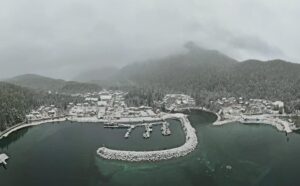By 2026 Gitga’at First Nation hopes to build a new hydroelectric facility that will power, among other things, its electric fleet

The Gitga’at First Nation is building a hydroelectric facility in Hartley Bay, B.C. Photo: Gitga’at First Nation/Facebook
By 2026 Gitga’at First Nation hopes to build a new hydroelectric facility that will power, among other things, its electric fleet
A new kind of energy is coursing through the Hartley Bay area — one that its 130 in-community members hope will last for decades to come.
The Gitga’at First Nation’s main community in Hartley Bay on the coast of British Columbia is breaking ground on a new wholly Indigenous-owned 900-kilowatt hydroelectric facility.
The project is expected to go into operation in October 2026 and meet 95 per cent of the community’s electricity needs for 40 years.
Located roughly 630km north of Vancouver and 145km south of Prince Rupert, Hartley Bay is accessible only by air or water. It gets its power from diesel fuel generators (along with 43 other remote communities in B.C.) but, in 2003, it conceived of a plan to build a small storage run-of-lake hydroelectric facility.
Now, over 20 years later, the community is moving forward.
“The electricity produced will feed into the power grid, and the Gitga’at First Nation will sell it back to BC Hydro,” reads the community’s website.
“This project will greatly reduce the community’s reliance on diesel generation plants, reduce carbon emissions, and help the environment.”
Decarbonized electric fleet
The Hartley Bay community is roughly a kilometre across end-to-end. The compact distance and fairly temperate climate means the community has relied for decades on roughly 20 electric golf carts for land transportation. As well the community has two electric vehicles.
The electric fleet has had to rely on diesel generators to provide electricity to refuel.
With a hydroelectric microgrid the Gitga’at First Nation community will not only displace over 500,000 litres of diesel each year, but it will also get to fully realize the benefits of an electric fleet powered by clean energy.
As well, confirms the community’s clean energy lead, David Benton, there is also a plan to purchase an electric truck for the community. Should the community adopt more EVs, installing a public charging station would likely follow.
To finance construction of the hydroelectric facility the Gitga’at First Nation received $2 million in B.C. government funding from the Community Energy Diesel Reduction (CEDR) program. Previously, another $2 million was awarded to the community from CEDR in 2023.






